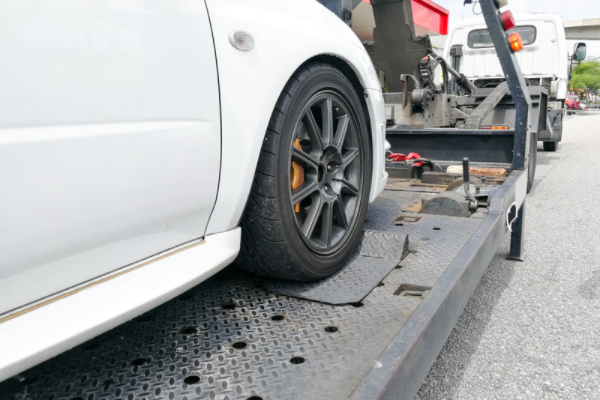Uh-oh. Did the bank take your car away? What now, you ask?
Losing your car is painful and stressful as it is. The hard-earned money you’ve paid for the monthly installments is gone in an instant. Having no car suddenly can also jeopardize your work or business. It doesn’t help that the messy, inefficient public transportation system in the Philippines doesn’t offer an alternative to car-less Pinoys.
What happens next could be very nerve-wracking, but it’s the ugly consequence of failing to repay your car loan on time. Here’s what you need to know about car repossession in the Philippines and the steps you can take after going through the experience of having a repossessed car.
What is Car Repossession?
In the Philippines, car repossession happens when your bank takes your vehicle because of failure to pay your car loan. Lenders can seize your vehicle as soon as you fail to make your loan payments as agreed in the contract.
Should you default on your loan, your bank can charge you the following:
- Extrajudicial Foreclosure Under the Chattel Mortgage Law (Act No. 1508) for voluntary surrender of a vehicle in the Philippines[1]
- Judicial Foreclosure of the Chattel Mortgage for refusing to surrender your car. Your bank may file for a Replevin Case.[2] The court will then issue an order, allowing authorities to repossess the car under any circumstance.
How Many Months Does It Take Before a Car Repossession Happens?
Your bank can’t immediately take away your vehicle just because you missed one monthly payment. Typically, car repossession happens after three consecutive months of failure to pay a car loan.
That means your vehicle is in danger of a repossession when you miss at least three monthly payments. However, the maximum period will still depend on what is stated in your car loan agreement with the bank.
Car Repossession Process in the Philippines

What happens if your car gets repossessed in the Philippines? You might wonder.
Car repossession follows a process. Under the law, your bank should do the following first:
- Give you notice that your car is about to be repossessed. You'll then be given 21 days to act on it.
- Send you another notice after 14 days. You can pay your missed payments, return your car, or allow the bank to proceed with repossessing your car.
- Proceed with the car repossession if you didn’t make the payment
- Send another notice. If you pay your car loan, you can take your repossessed car back. Also, you can find another person who will purchase your vehicle.
- Sell the repossessed car in a public auction after 21 days of failure to pay your car loan.
Take note that during the car repossession process, the people who are taking your car cannot use any form of violence or physical force against you. Additionally, they should not insult you or use foul language. Lastly, they cannot seize your belongings inside the repossessed car.
Apart from being authorized to sell the repossessed car in the Philippines, the bank can also charge you with a “deficiency” fee that you still owe them. There may be a deficiency hearing, and your bank may use any of your assets to pay off the unpaid car loan balance.
Having Repossessed Car Issues? Here's What You Can Do

Here are seven steps you can do when your car is repossessed:
1. Find Out Why the Car Got Repossessed
If you’ve stopped making monthly payments on your loan, the reason for the car repossession is obvious. The bank owns the car until you’ve paid the loan off, so it has the right to take back the vehicle due to your failure to pay the car loan.
However, if you’re on top of your loan payments and believe the repossessed car incident was a mistake, contact your bank immediately to find out the reason so that you can correct the situation.
Car repossession may happen for reasons other than failure to repay a car loan. The repo guy may have taken the wrong car. There might be some issues (on the bank’s end) with processing or recording your payments. Or your account might have been incorrectly tagged as delinquent. Or worse, it might be a case of the “assume balance” or pasalo scam.[3]
2. Get Your Belongings Back
The authorities cannot withhold your personal items from the repossessed car. Coordinate with the bank on how to claim your belongings. If anything is missing or damaged, report it to the bank for immediate action.
3. Decide If You Can Afford to Recover Your Car
Yes, you can get your repossessed car back. However, it isn’t going to be easy. You need to act fast and come up with a realistic solution that won’t put you in deeper debt.
Here are three possible options to recover your repossessed car:
- Redeem the car. To get your seized car back, pay the full loan amount due plus the storage and repossession fees before the bank puts the vehicle up for sale. The bank may have sent you a notice of sale, informing you of the time period and how to redeem the repossessed car.
- Restore your car loan. You may be allowed to reinstate your loan by settling the unpaid balance plus the storage and repossession fees.
- Buy the repossessed car back. This may sound like an absurd idea, but if the car has sentimental value to you, it may be worth spending money on. The bank may allow you to bid on the car when it’s up for sale.
Whether or not to recover your repossessed car is a serious decision to make. If you choose to go ahead with it, be warned that it might strain your finances. You might be tempted to borrow money from relatives and friends, which is a bad idea because you’re just burying yourself deeper in debt.
Read more: Is It Good to Buy a Repossessed Car? Consider These Pros and Cons
Take a long and hard look at your financial situation. Your car got repossessed for a reason—you cannot afford the vehicle you purchased. Is taking your car back worth the trouble? Can you manage to get back on your feet again after you retrieve the car? Will your situation improve over time? Give these things a careful thought before you attempt to recover your repossessed car.
4. Negotiate Your Loan with the Bank
No harm in trying to negotiate a car loan restructure with the bank. This will make your loan repayments easier and more affordable for you. Or the bank may give you other options to consider.
If the bank doesn't agree to restructuring your loan, you might want to get a new loan from another lender, so you can fully pay off your car loan.

5. Decide If You’ll Keep or Cancel Your Car Insurance Policy
If you have comprehensive car insurance and the financial means to get your repossessed car back, keep your policy active. The car insurance may pay for any damage the car incurred during repossession.
On the other hand, if you have the liability-only coverage and you can’t get the repossessed car back, it’s better to cancel the insurance right away rather than pay for it when you’re no longer using the vehicle. A repossession will increase your insurance rate on your next vehicle because of your bad credit history. But you can still reduce the insurance cost on your next car.
Read more: What Happens If I Stop Paying My Car Insurance?
6. Let It Go
Rather than spending your money on saving your repossessed car, you might be better off letting it go and saving up to buy a second-hand car. It’s a tough call, but it can be the only way to get out of a potential financial problem.
This time, be wiser and realistic about your next car purchase, so you’ll never have to experience getting your car repossessed again. Choose a reliable vehicle you can afford. Check out this article for tips on buying a used car.
7. Improve Your Credit Score
Having your car repossessed puts a dent in your credit score, making it harder for you to get approved for new loans in the future. However, you can turn things around. For example, get a secured credit card, use it responsibly, and pay your credit card bills on time.
4 Tips to Avoid Car Repossession

No one wants their beloved car taken away from them. If you have the means, you can avoid your car being repossessed. Here are some tips you can consider.
1. Consistently Make Your Car Loan Payments
It’s a no-brainer. If you’re updated on your monthly payments, your bank won't repossess your car. Make sure to plan your finances and allot money—not just for your car loan—but for your other debt repayments. It will save you from headaches in the future.
2. Talk to the Bank
If you’re in a tight financial spot, get on the phone with your bank and explain your situation. They may be open to working with you. Your bank may give you more time to make your car loan payment.
As soon as you make the payment, get the receipt showing you’ve completed it. This will be useful when the repo man comes around.
3. Consider Refinancing
If you can’t afford your car loan payments anymore, consider asking your bank about a refinance. Yes, you can do this! You can ask to extend your car loan term or lower your payment to an an affordable amount every month.
4. Sell Your Car
Sell your vehicle and pay off your entire car loan. If you can’t afford to pay for your car, its insurance, and the fees that come with car ownership, you may be better off without it. Instead of waiting for the repo man to take your car away and ruining your credit history in the process, this may be a better option.
It can be tough, especially if the car has a sentimental value to you. However, it will get the bank off your back. You also don’t have to worry about the monthly payment again.
Final Thoughts
You may feel helpless, seeing your treasured ride taken away. While you cannot control everything that happens in your life, you can prevent car repossession from happening. Stay updated with your payments. Talk to your bank if you're in a difficult financial situation and would want to refinance your car loan.

Sources:
- [1] Chattel Mortgage (BATASnatin)
- [2] Car Repossession vs Replevin (Lane, Nolo)
- [3] Bangko Sentral warns of 'pasalo-benta' auto loan scam (Rappler, 2021)









